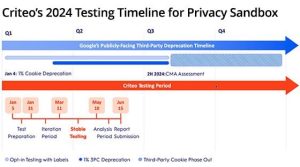Harness the potential of AI and agile marketing to revolutionize your customer engagement efforts and exceed expectations.

Providing genuinely outstanding customer experiences is the ultimate goal of marketers today. Customers have come to expect seamless, personalized brand interactions across all touchpoints. However, meeting these heightened expectations is no easy feat.
Fortunately, marketers now have powerful new tools to help them understand and predict customer behaviors at scale — artificial intelligence (AI) and agile ways of working. This guide provides a roadmap for leveraging AI and agile marketing practices to craft unforgettable customer experiences.
Step 1: Establish your data foundation
The first step for creating great experiences using AI and Agile marketing is laying your data foundation, which can feel daunting. To address the complexities of wrangling data, many marketers have turned to the agile marketing principles of cross-functionality and incrementalism, which help alleviate the overwhelm.
To build cross-functional teams, determine the data you need for an exceptional, personalized customer experience. Then, determine who in the organization represents or owns the data you need. Depending on factors such as data accessibility and the depth of data needed, consider inviting the representative or owner of the data onto your team.
Adding these individuals to a working group or team reduces silos, back-and-forth and turf wars to ensure your data is clean, consistent and accessible. This cross-functional approach also helps the organization promote knowledge sharing and create the culture of transparency needed to establish the data foundation.
While making big, radical changes to your data foundation is tempting, consider adopting a mindset of incrementalism. Start where you are and make small changes over time. This keeps data initiatives from getting bogged down in large budget discussions or hindered by coordination issues. Getting the basics of a data foundation in place is critical for using AI in customer experiences.
Step 2: Integrate additional agile approaches
The next step is integrating additional agile approaches into your customer experience teams, such as implementing iterations. Iterations means breaking down work into smaller chunks that can be delivered regularly, such as every two weeks. The bigger the deliverable, the more likely it is to encounter delays, blocks or get off track. Iterations maintain workflow and mitigate risks in your projects.
Use visualizing work for transparency and quick communication. The brain processes images 65,000 times faster than words. Many teams who visualize their work can easily see how much work is in progress and what work is blocked or not moving. Visualizing work establishes predictability and flexibility in marketing teams — all essential to optimizing the customer experience.
The regular cadence of iterations, combined with regular reflection points, called retrospectives in agile, allows the teams to identify lessons learned and improvement items. These reflection points allow teams to continually refine their approach as they optimize the customer experience with AI tools.
Step 3: Leverage AI analytics for customer insights
With all that in place, it’s time to identify how you can use AI analytics to drive customer insights. Will you use predictive analytics for personalized experience? Will you use AI-powered tools for sentiment analysis?
If you can, make use of real-time customer behavior tracking, and the creation of dynamic user personas or customer segments. Start with your business objectives and work back from there. For example, if you are working to improve your brand reputation, an AI sentiment analysis tool makes more sense than one that predicts churn rates. Without focus, it is easy to get lost chasing the next new tool.
Make time and space for your marketing teams to explore, learn about and get trained on these tools. This will uncover insights into customer behavior, preferences and trends that can inform personalized marketing strategies.
Step 4: Personalization and content optimization
Now you are ready to add in personalization and content optimization. Here is where agile marketing approaches like experimentation come into play. Use the insights generated in the previous steps to structure well-formed experiments. A well-formed experiment states a hypothesis and how you will know the hypothesis is true and how you will know it is false.
Say your AI sentiment tool finds a recent downturn in credibility with your automotive clients. You hypothesize that a series of custom automotive customer stories will improve this metric. Most marketers stop there, run the experiment and make a judgment call on whether or not it worked using fuzzy metrics. A well-formed experiment defines these metrics upfront. You might state, “The experiment succeeds if our credibility sentiment increases by 5% and fails if it stays flat or increases by less than 2%.”
AI-Insights + Personalization + Experimentation = Continually improving customer experiences
Step 5: Measuring outcomes
Running well-formed experiments grounded in business objectives keeps marketers focused on outcomes over outputs. It is not enough to implement an AI tool. It isn’t enough to generate data and insights. It isn’t enough to personalize content. It is only enough when the customer has a truly exceptional experience — which must be measured.
When developing your data foundation, you must consider the data needed to create an amazing customer experience and how you will measure its success.
Leveraging AI and agile marketing for unforgettable customer experiences
Creating exceptional customer experiences with AI isn’t as easy as chasing the latest AI tool. Marketers need to think through their data foundation, identifying which data will be used to drive the customer experience, measuring outcomes and determining where that data lives.
Agile marketing concepts like visualizing work and using iterations keep work flowing and allow flexibility as marketing starts to generate AI-driven customer insights. Well-formed experiments action those insights. Following this guide lets you combine AI and agile marketing to build unforgettable customer experiences.
The post Crafting exceptional customer experiences with AI and agile: A 5-step guide appeared first on MarTech.
(31)
Report Post






